Hernia Mesh Devices Market Size and Share
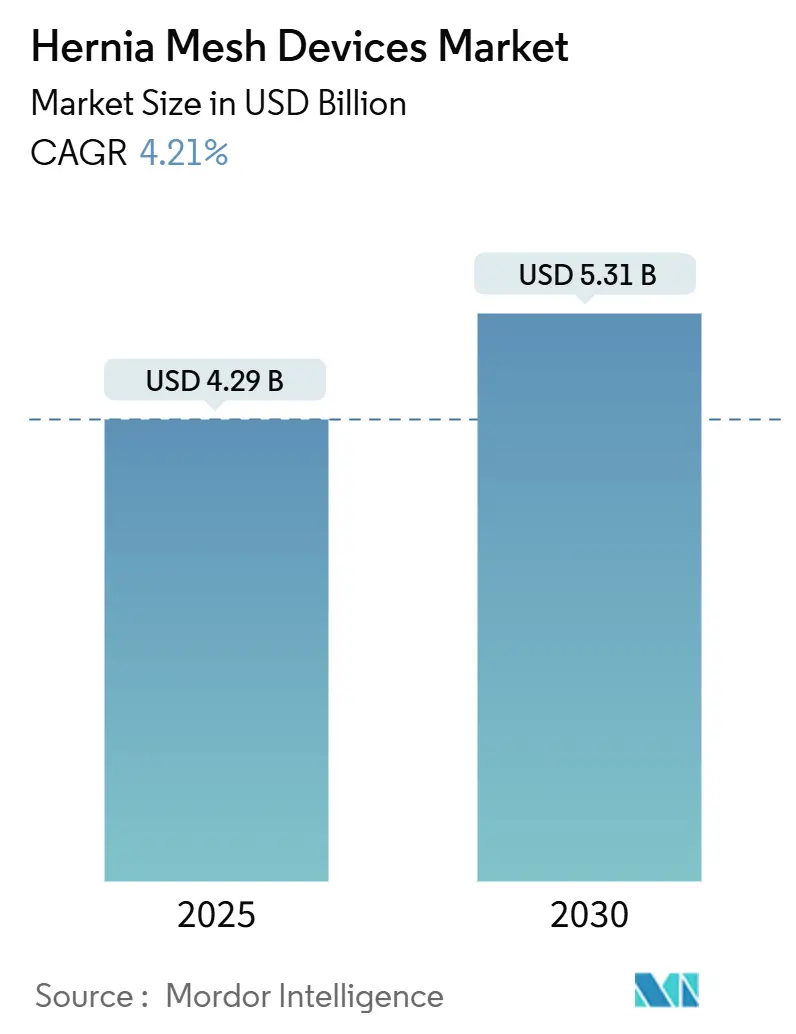
Hernia Mesh Devices Market Analysis by Mordor Intelligence
The hernia mesh devices market size generated USD 4.29 billion in revenue in 2025 and is forecast to reach USD 5.31 billion by 2030, advancing at a 4.21% CAGR between 2025 and 2030. Demand expands steadily because mesh repair has become the reference standard in most surgical guidelines, yet growth remains moderate in mature North American and European systems while accelerating in Asia-Pacific and parts of Latin America. Rising obesity, wider access to ambulatory surgery, and the migration toward minimally invasive and robotic techniques underpin new unit volumes, even as litigation pressures and selective product recalls temper momentum. Composite and fully absorbable materials are widening clinical options and reshaping procurement criteria, while reimbursement reforms continue to reward procedure efficiency and early discharge. Competition centers on safety differentiation, cost-effectiveness, and regional approval strategies for barrier-coated designs, with suppliers balancing innovation against heightened regulatory scrutiny.
Key Report Takeaways
- By hernia type, inguinal repairs accounted for 72% of the hernia mesh devices market share in 2024, whereas Incisional / Ventral Hernia repairs are projected to register the fastest CAGR of 7.2% from 2025-2030.
- By mesh type, synthetic meshes captured 85.1% revenue share in 2024; biologic meshes are expected to post the highest growth rate of 8.5% over 2025-2030.
- By mesh material, non-absorbable formulations led with 78.4% share of the hernia mesh devices market size in 2024, while fully absorbable P4HB meshes are forecast to expand the fastest CAGR of 9.1% through 2030.
- By surgical technique, open repair held 57.8% revenue share in 2024; robotic-assisted repair is projected to deliver the strongest CAGR of 10.3% during 2025-2030.
- By end-user, hospital settings commanded 48.6% of 2024 revenue, whereas ambulatory surgical centers are likely to log the highest growth pace of 8.3% to 2030.
- By geography, North America dominated with 41.3% of global revenue in 2024; Asia-Pacific is forecast to rise at a 6.9% CAGR through 2030.
Global Hernia Mesh Devices Market Trends and Insights
Drivers Impact Analysis
| Driver | Impact on CAGR | Geographic Relevance | Peak Impact |
|---|---|---|---|
| Rising incidence of ventral and umbilical hernias in obese adults | ~+0.6 | Global; highest in North America & Middle East | Long term (≥ 5 yrs) |
| Shift toward minimally invasive and robotic repair | ~+0.4 | North America, Europe, South Korea | Medium term (3-4 yrs) |
| Innovation in lightweight, composite, and anti-adhesion meshes | ~+0.3 | Global | Long term (≥ 5 yrs) |
| Broadening reimbursement coverage for mesh-based repair | ~+0.2 | United States, selected EU markets | Short term (≤ 2 yrs) |
| Growth of ambulatory surgery centers and same-day discharge protocols | ~+0.3 | United States, Canada, Australia, selected Asia-Pacific markets | Short term (≤ 2 yrs) |
| Strategic M&A and distribution alliances speed worldwide rollout of next-generation mesh portfolios | ~+0.2 | Global | Medium term (3-4 yrs) |
| Source: Mordor Intelligence | |||
Rising Incidence of Ventral & Umbilical Hernias in Obese Populations
Global obesity prevalence continues to climb, and 60% of the 350,000 annual ventral hernia repairs already involve patients with elevated body-mass indices[1]Pablo Omelanczuk, “Ventral Hernia Repair in Obese Patients: Risks and Benefits,” General Surgery News, generalsurgerynews.com. Higher BMI correlates with longer operative times, greater recurrence risk, and a preference for reinforced mesh designs that can manage increased intra-abdominal pressures. Surgeons are evaluating synthetic, biologic, and bioabsorbable materials more critically, seeking tailored strength, pore architecture, and infection-resistance. Suppliers have responded with reinforced yet lightweight constructs that maintain tensile integrity in challenging anatomies and promise fewer postoperative complications. These purpose-built products expand the total addressable base for the hernia mesh devices market, particularly in bariatric centers of excellence.
Rapid Migration toward Minimally Invasive Repair Techniques
Robotic-assisted hernia repair precedures grew at rapid pace till 2024. Although robotic cases add about USD 32,962 in cost relative to laparoscopic repairs, payers increasingly reimburse on bundled episode-of-care models that reward reduced readmission. The learning curve stands near 12 cases, accelerating surgeon conversion. Mesh vendors are redesigning deployment systems with pre-attached sutures, shape memory rings, and hydrogel coatings that unfurl consistently through narrow trocars. Initial enthusiasm faces tempered expectations after 10-year Medicare data indicated a 1.1% higher recurrence versus laparoscopy, yet procedural precision and ergonomic advantages keep robotic use on an upward path within the hernia mesh devices market.
Ongoing Innovation in Lightweight, Composite, and Anti-adhesion Meshes
Manufacturers invest in polymers that lower foreign-body response while preserving strength. BD’s Phasix platform employs fully absorbable P4HB, degrading over 12-18 months and leaving structured collagen deposition[2]Becton Dickinson, “BD Launches Industry-First Bioabsorbable Mesh Designed for Umbilical Hernia Repair,” investors.bd.com. The April 2025 release of the Phasix ST Umbilical Hernia Patch, the first bioabsorbable device purpose-built for umbilical repair, aligns with survey data showing 60% of patients prefer non-permanent implants. Nanometer-scale surface modification, exemplified by Exogenesis Accelerated Neutral Atom Beam processing, further improves tissue integration without sacrificing porosity. Composite meshes featuring bioresorbable barriers target adhesion reduction, but published recurrence ranges of 0-11.1% and infection ranges of 0-21% underscore the need for rigorous comparative studies.
Broadening Reimbursement Coverage for Mesh-based Hernia Repair
CPT revisions in 2023 codified mesh placement within anterior abdominal hernia repair descriptors, cementing mesh as standard of care. Medicare payments span USD 1,622–5,503 depending on complexity, boosting revenue predictability for ambulatory surgical centers[3]National Institute for Health and Care Excellence, “Cyanoacrylate Glue for Hernia Mesh Fixation,” nice.org.uk. Outpatient penetration now reaches 81% in the United States, narrowing facility margins yet rewarding providers that streamline inventory and operative times. Reimbursement parity still lags for extended totally extraperitoneal (eTEP) and other newer techniques, leaving approval agencies and private payers to evaluate long-term cost offsets. In Europe, cyanoacrylate glues such as Histoacryl LapFix and LiquiBand Fix8 entered NICE’s advisory pathway, enabling non-tacking fixation that can shorten stay by 0.5 days while costing as little as £134 (181.06 USD) per kit[4]California Medical Association, “Medi-Cal Assigns Reimbursement Rates to 12 Hernia Repair Service Codes,” cmadocs.org.
Restraints Impact Analysis
| Restraint | Impact on CAGR | Geographic Relevance | Peak Impact |
|---|---|---|---|
| High per-procedure cost of biologic and biosynthetic meshes | ~-0.4 | Emerging markets; select OECD payers | Medium term (3-4 yrs) |
| Product recalls and large-scale litigation | ~-0.5 | United States; spill-over in Europe | Long term (≥ 5 yrs) |
| Lag in regulatory approvals for novel barrier-coated mesh in key regions | ~-0.3 | European Union, Japan, select Middle East markets | Short term (≤ 2 yrs) |
| Availability of suture-only tissue repairs for small defects | ~-0.2 | Latin America, Africa, Southeast Asia | Short term (≤ 2 yrs) |
| Source: Mordor Intelligence | |||
High Per-procedure Cost of Biologic & Biosynthetic Meshes
Fully processed porcine dermis or human cadaveric meshes can cost 8-15 times more than lightweight polypropylene, confining usage to contaminated fields or immunocompromised patients. Usage in open surgery falls from 98.9% in high-income countries to 72.1% in low-income settings, illustrating an affordability divide. Extended operative times and the need for specialist training further erode cost-effectiveness. This dynamic stimulates hybrid concepts that combine synthetic scaffolds with bioactive coatings to attain comparable remodeling at half the expense, yet payers demand robust registry data before endorsing widespread substitution. Until pricing narrows materially, budget-constrained hospitals will remain reliant on conventional synthetics, limiting immediate upside for premium materials within the hernia mesh devices market.
Product Recalls & Litigation Over Chronic Pain and Adhesion Risks
Becton Dickinson agreed in October 2024 to pay more than USD 1 billion to settle 38,000 mesh lawsuits, underscoring financial exposure from historical product lines. The Bard multidistrict litigation docket alone lists 22,896 cases, with filings still rising. Pending suits against Ethicon, Covidien, and Atrium shape surgeon sentiment and procurement committees, many of which pivot toward newer meshes with bolstered clinical documentation. Increased FDA and European vigilance over barrier-coated products lengthens review cycles and fragments launch timelines, compelling multinational vendors to tailor regulatory strategies by region. Heightened post-market surveillance has become a competitive necessity, raising compliance costs for newcomers and incumbents alike.
Segment Analysis
By Hernia Type: Ventral and Incisional Procedures Accelerate
In 2024, inguinal repairs represented 72.0% of volume, reflecting standardized techniques and high baseline incidence. Ventral and incisional repairs, however, post the quickest rise and will enlarge the hernia mesh devices market size for these subtypes at a forecast mid-single-digit CAGR. Climbing obesity rates, more laparotomy history, and improved imaging all inflate ventral case numbers. Manufacturers now pursue dedicated ventral solutions with pre-curved shapes and hydrogel-lined surfaces that guard against adhesion to viscera. The April 2025 launch of the bioabsorbable Phasix™ ST Umbilical Hernia Patch exemplifies targeted design for this under-served cohort.
The ventral surge also changes facility economics. Obese ventral cases typically require longer anesthesia and larger mesh footprints, lifting per-procedure material outlays and widening upsell opportunities for composite and biologic meshes. Surgeons weigh prophylactic mesh placement in high-risk elective laparotomies to curb future ventral defects, a practice that can increase prophylactic mesh penetration from the current 14% base in North America. This shift is projected to add incremental units and revenue to the hernia mesh devices market across academic medical centers and high-volume community hospitals.
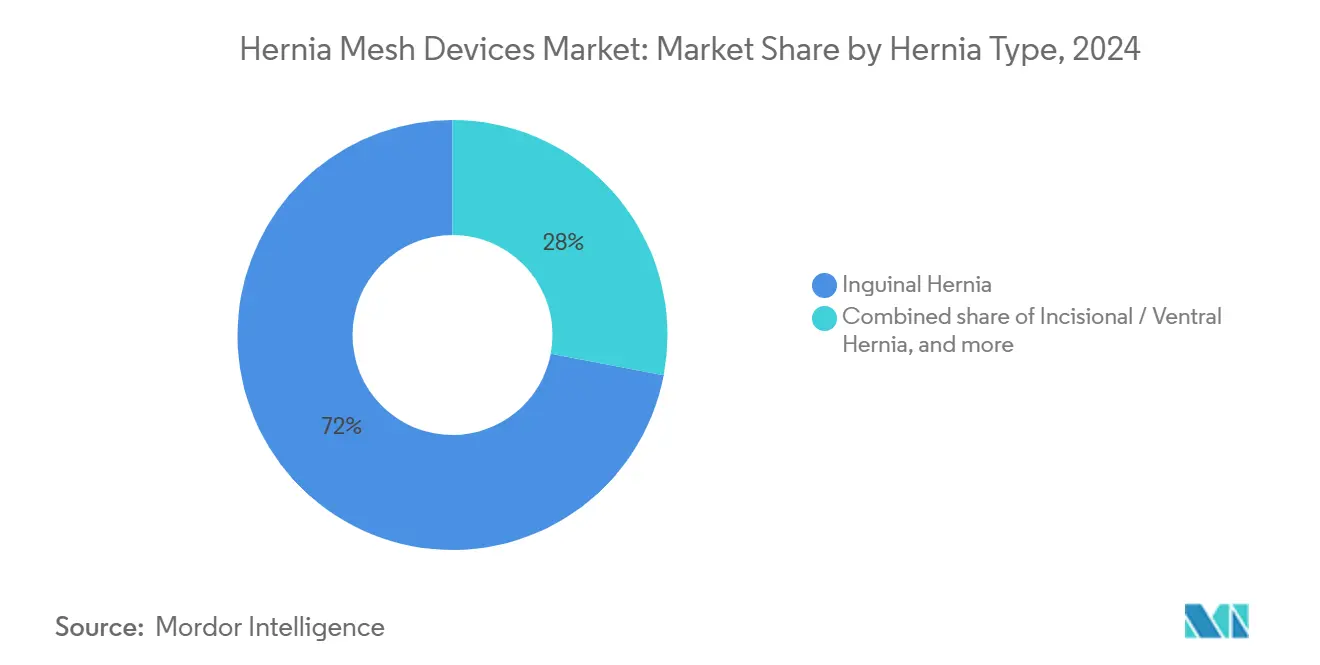
Note: Segment shares of all individual segments available upon report purchase
By Mesh Type: Biologic Alternatives Challenge Synthetic Leadership
Synthetic devices claim 85.1% revenue due to favorable cost-to-benefit ratios and decades of safety data. Nevertheless, biologic meshes are predicted to record the fastest growth, especially in contaminated fields where permanent polymers risk infection. Emerging hybrids such as TELA Bio’s Reinforced Tissue Matrix marry ovine collagen with resorbable polymeric reinforcement, seeking to balance strength with remodeling. Clinical registries indicate lower explant rates in complex settings, encouraging adoption despite price premiums.
Regulatory focus on long-term performance has raised the bar for new synthetics. Lightweight polypropylene variants with pore sizes above 1,500 µm and weights under 30 g/m² aim to lower chronic pain without compromising integrity. Composite meshes—bonding expanded polytetrafluoroethylene to polypropylene—tackle adhesion risk with smooth visceral surfaces. Successful differentiation in this core segment remains pivotal for sustaining overall growth in the hernia mesh devices market.
By Mesh Material: Absorbable Polymers Gain Ground
representing 78.4% of 2024 revenue. Fully absorbable P4HB products, however, log the highest CAGR outlook. Mechanical support lasts through the biologically critical first year, after which hydrolysis yields CO₂ and water, leaving native fascia to bear load. Early multicenter data report recurrence below 5% at 24 months for mid-grade defects, supporting payer reimbursement in the United States.
Adoption remains constrained by elevated unit prices and cautious surgeons who want five-year evidence. Some facilities adopt a blended strategy using P4HB in high-risk or cosmetic cases while maintaining polypropylene for low-risk inguinal repairs. These parallel usage patterns widen the total hernia mesh devices market while preserving share for legacy polymers. Continuous improvements in polymer chemistry, such as slow-degrading glycolide-trimethylene carbonate blends, promise to broaden absorbable indications beyond current barriers.
By Surgical Repair Technique: Robotics Reshape Clinical Workflows
Open repair generates 57.8% of revenue, underpinned by resource-limited hospitals and straightforward inguinal cases. Robotic-assisted approaches draw the fastest adoption curve, reaching 22.4% penetration in certain U.S. centers and expanding internationally as Medtronic’s Hugo™ and CMR Surgical’s Versius platforms enter service. Early series document console times of 37 minutes for unilateral inguinal defects with no intraoperative complications, though operation length often exceeds laparoscopic benchmarks.
Mesh suppliers tailor product packaging for robotic delivery, integrating stay sutures and elastic memory frames. As facilities strive to amortize capital investment, robotic case mix shifts toward complex ventral and recurrent hernias that require larger mesh panels and fixation adjuncts, boosting per-case disposables. Nevertheless, payer scrutiny of long-term recurrence holds surgeons accountable for evidence-based technique selection, reinforcing the need for randomized trials comparing robotic and laparoscopic outcomes.
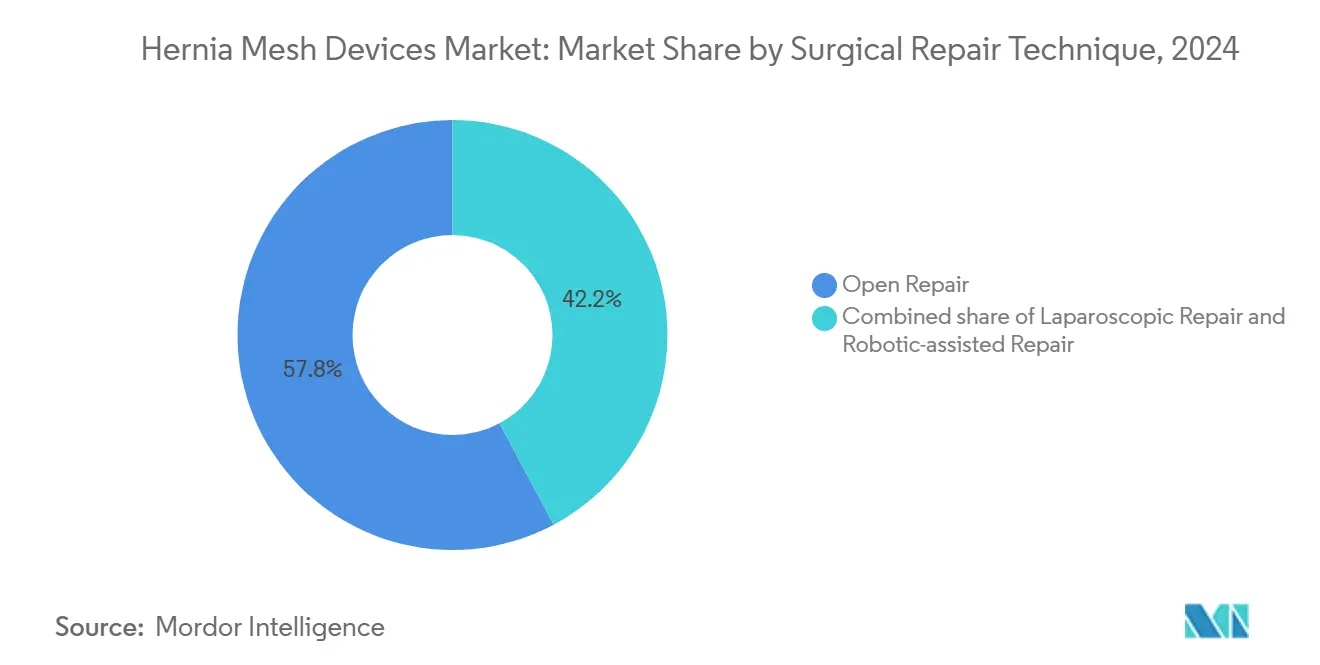
Note: Segment shares of all individual segments available upon report purchase
By End-User: Ambulatory Centers Expand Footprint
Hospitals retained 48.6% of global sales in 2024, but ambulatory surgical centers exhibit the strongest growth trajectory. Outpatient conversion accelerates whenever anesthesia times shorten and same-day discharge becomes safe. ASCs frequently negotiate capitated supply contracts, prioritizing meshes that deploy rapidly and minimize postoperative pain. Device makers respond with pre-loaded suture passers, fixation glue kits, and smaller packaging to streamline turnover. Average hernia repair costs in ASCs stand 40-60% below hospital averages, incentivizing payers to steer uncomplicated inguinal and small ventral cases toward these facilities. For vendors, this channel shift elevates volume potential while squeezing unit margins, making cost-optimized SKUs essential to maintain share within the hernia mesh devices market.
Geography Analysis
North America captured 41.3% of 2024 revenue and remains the reference market for innovation. The United States records more than 1 million hernia repairs each year, incurring USD 2.5 billion in aggregate procedure costs. Reimbursement inclusion of mesh in CPT descriptors and widespread ASC adoption promote stable unit growth. Litigation risk, exemplified by BD’s USD 1 billion agreement to resolve 38,000 suits, drives hospital committees to request enhanced clinical evidence and post-market surveillance commitments. Robotic repairs are increasing rapidly, though 10-year Medicare data citing 1.1% higher recurrence than laparoscopy have moderated expansion in some integrated delivery networks.
Europe ranked second in 2024 revenue. The HerniaSurge Group guidelines endorse mesh for inguinal repairs, especially Lichtenstein and laparo-endoscopic techniques. European surgeons show strong interest in atraumatic fixation; cyanoacrylate glues such as LiquiBand Fix8 and Glubran2 reduce postoperative pain and hospital stay at varying price points. Regulatory oversight is stringent under the Medical Device Regulation, compelling manufacturers to conduct post-market performance studies across multi-country cohorts. Adoption of prophylactic mesh during open abdominal surgery is comparatively high, with 54% of European surgeons implanting mesh when discovering occult hernias, lifting the hernia mesh devices market size at the continent level.
Asia-Pacific is forecast to grow at 6.9% CAGR from 2025 to 2030, the fastest worldwide. Sharp disparities in infrastructure result in mesh usage rates during open surgery falling to 72.1% in low-income countries, but rising insurance coverage and surgeon training are closing gaps. South Korea leads robotic penetration; a single-center study reported zero intraoperative complications in 35 robotic inguinal repairs on the Da Vinci Xi system. China expands reimbursement for day-surgery inguinal repairs, driving polypropylene demand, while India emphasizes cost-efficient lightweight synthetics. Vendors competitive in this price band gain scale quickly. Addressing supply bottlenecks and enabling credentialing programs remain prerequisites for sustained expansion across diverse Asia-Pacific markets.
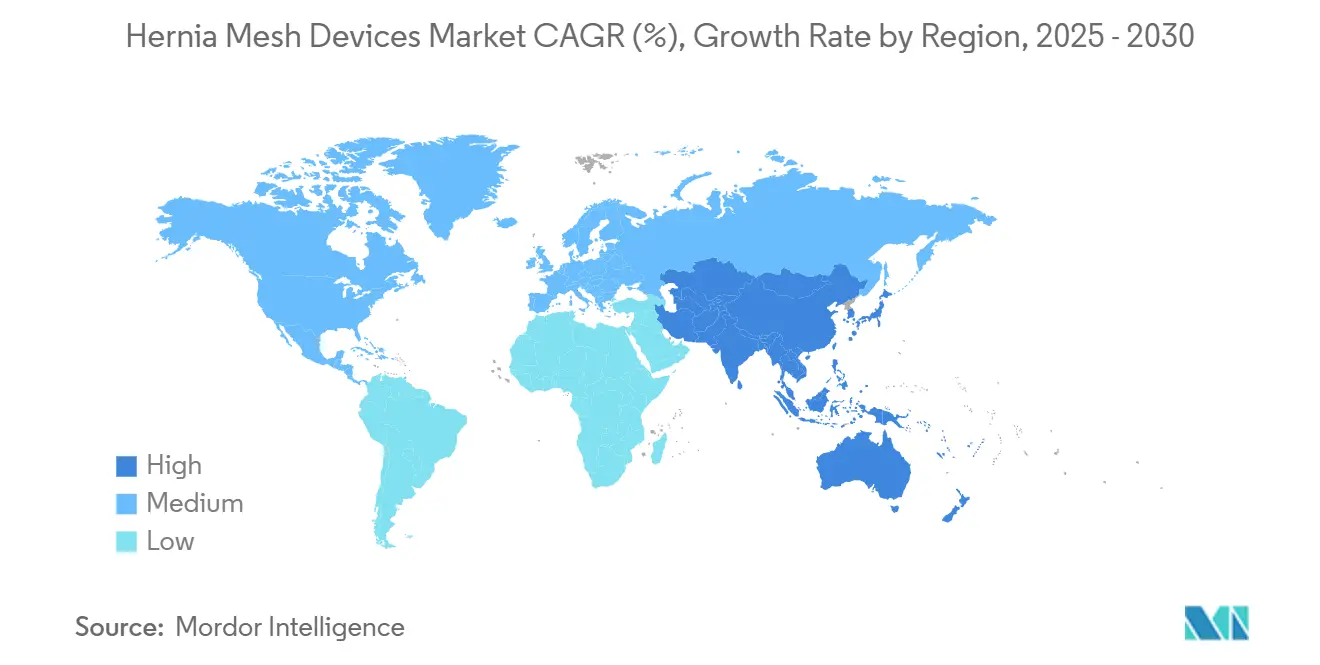
Competitive Landscape
The hernia mesh devices market displays moderate concentration. Medtronic, Ethicon, and BD anchor the top tier through broad product suites and global distribution. Together they exceed 55% combined share, while a second tier of players such as Gore, Atrium (Maquet Getinge), and TELA Bio compete on specialized materials or fixation systems. Ongoing multidistrict litigation raises the strategic value of strong safety dossiers; firms able to demonstrate low chronic pain and infection rates gain formulary preference. Portfolio breadth matters: Medtronic’s Symbotex composite meshes complement its Hugo™ robotic platform, fostering cross-selling.
Acquisition and licensing remain key. BD augmented its synthetics range by absorbing Davol, while Ethicon expanded bioabsorbable capability through its Biosurgery division. Smaller innovators pursue white-space. Deep Blue Medical Advances markets T-Line Hernia Mesh with integral suture extensions that distribute tension and reduce migration; more than 8,000 units have been implanted without reported adverse events. Material science is a discriminant: Exogenesis applies nano-modified surfaces for improved tissue compatibility, and GORE DUALMESH employs dual-surface PTFE to pair fixation strength with anti-adhesion benefits.
Regional product approval pathways spur differentiated strategies. Barrier-coated constructs delayed by FDA queries often reach Europe first under the CE mark, while Japan favors domestically manufactured meshes to manage supply chain risk. Companies actively compile large real-world evidence registries to anticipate MDR post-market surveillance requirements. Strategic moves such as price-tiered product ladders, surgeon training platforms, and supply agreements with ambulatory surgery chains will influence share trajectories over the forecast horizon.
Hernia Mesh Devices Industry Leaders
-
Medtronic Plc
-
W. L. Gore & Associates, Inc.
-
Ethicon Inc. (Johnson & Johnson)
-
Becton, Dickinson and Company
-
B. Braun SE
- *Disclaimer: Major Players sorted in no particular order
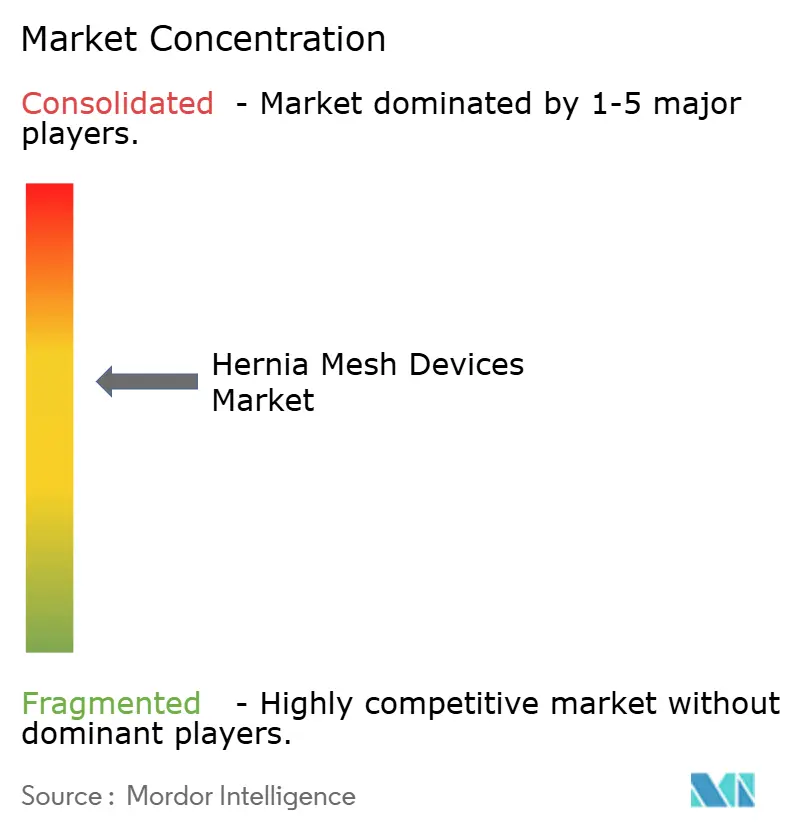
Recent Industry Developments
- April 2025: BD introduced the Phasix ST Umbilical Hernia Patch after receiving FDA 510(k) clearance, marking the first bioabsorbable mesh designed specifically for umbilical hernia repair.
- October 2024: Becton Dickinson agreed to pay over USD 1 billion to resolve 38,000 surgical mesh lawsuits, settling the bulk of existing claims.
- May 2024: California’s Department of Health Care Services updated reimbursement rates for CPT 49591-49596 and 49613-49618, providing greater payment consistency for ventral hernia repairs
- April 2024: Deep Blue Medical Advances confirmed the spring launch of the T-Line Mini mesh for umbilical hernia repair, extending its tension-distribution technology to smaller defects
Research Methodology Framework and Report Scope
Market Definitions and Key Coverage
Our study defines the hernia mesh devices market as the value of newly manufactured synthetic, biologic, or hybrid mesh implants supplied for surgical reinforcement of abdominal wall defects across all hernia types. The scope tracks factory-gate revenues, not procedural fees or ancillary fixation tools.
Scope Exclusions - One-line Note. Staples, tacks, glues, sutures, robotic arms, and other fixation accessories are excluded.
Segmentation Overview
- By Hernia Type
- Inguinal Hernia
- Incisional / Ventral Hernia
- Femoral Hernia
- Other Hernia Types
- By Mesh Type
- Synthetic Mesh
- Biologic Mesh
- Bio-synthetic / Hybrid Mesh
- By Mesh Material
- Non-absorbable (Polypropylene, ePTFE, Polyester)
- Partially-absorbable (PP + PGA/PLA)
- Fully-absorbable (P4HB, PGA)
- By Surgical Repair Technique
- Open Repair
- Laparoscopic Repair
- Robotic-assisted Repair
- By End-User
- Hospitals
- Ambulatory Surgical Centres
- Other End-Users
- Geography
- North America
- United States
- Canada
- Mexico
- Europe
- Germany
- United Kingdom
- France
- Italy
- Spain
- Rest of Europe
- Asia-Pacific
- China
- Japan
- India
- South Korea
- Australia
- Rest of Asia-Pacific
- Middle-East and Africa
- GCC
- South Africa
- Rest of Middle East and Africa
- South America
- Brazil
- Argentina
- Rest of South America
- North America
Detailed Research Methodology and Data Validation
Primary Research
We interview general surgeons, minimally invasive specialists, supply-chain managers at group purchasing organizations, and material scientists across North America, Europe, Asia-Pacific, and Latin America. Their inputs validate mesh utilization rates, biologic adoption hurdles, typical ASP discount ladders, and regional coding-reimbursement nuances, allowing us to close data gaps and fine-tune model assumptions.
Desk Research
Mordor analysts begin with open datasets such as the WHO Global Health Observatory, OECD Health Statistics, United States CDC National Inpatient Sample, and the European Hernia Society registry, which map procedure incidence and technique mix by country. Trade-body reports (Medical Device Manufacturers Association), peer-reviewed journals in Surgical Endoscopy, customs import records, and filings retrieved from D&B Hoovers and the FDA 510(k) database further clarify mesh volumes, material splits, and average selling prices (ASPs). These publicly available sources, alongside paid feeds from Dow Jones Factiva and Questel patent analytics, collectively anchor baseline demand and technology trends. The list is illustrative, not exhaustive.
Market-Sizing & Forecasting
A top-down procedure-pool model converts country-level hernia repair volumes into mesh unit demand using surveyed penetration ratios, which are then stress-tested against sampled manufacturer ASP × volume roll-ups from hospital channel checks. Key drivers include elective surgery backlog clearance, shift toward ambulatory centers, FDA biologic approvals, polypropylene price movements, and robotic-assisted repair share gains. Forecasts rely on a multivariate ARIMA that links mesh uptake to aging population growth, obesity prevalence, and disposable income trajectories, with scenario adjustments vetted by interviewed surgeons. Residual bottom-up gaps are bridged through selective supplier roll-ups.
Data Validation & Update Cycle
Outputs pass multi-step variance checks and peer review. Material deviations trigger re-contacts with sources. Reports refresh annually, and any recall, litigation, or reimbursement shock prompts an interim update before client delivery.
Why Mordor's Hernia Mesh Devices Baseline Earns Trust
Published estimates often diverge because firms pick different device mixes, pricing tiers, and refresh cadences.
Key gap drivers include whether fixation kits are bundled, how biologic meshes are weighted, the ASP progression method, and the frequency of exchange-rate resets. Mordor's disciplined scope, annual refresh, and dual-approach modeling mitigate these variables, yielding a balanced baseline for decision-makers.
Benchmark comparison
| Market Size | Anonymized source | Primary gap driver |
|---|---|---|
| USD 4.29 B (2025) | Mordor Intelligence | - |
| USD 5.58 B (2024) | Global Consultancy A | Bundles fixation devices and ventral patch systems, inflating total |
| USD 4.96 B (2024) | Industry Tracker B | Applies retail ASPs without channel discount adjustments |
| USD 2.29 B (2024) | Trade Journal C | Focuses mainly on biologic meshes sold in North America |
These contrasts show that, by selecting the right product universe and validating every assumption through field feedback, Mordor Intelligence delivers a transparent, reproducible baseline clients can rely on for strategic planning.
Key Questions Answered in the Report
What is the current hernia mesh devices market size and growth outlook?
The hernia mesh devices market generated USD 4.29 billion in 2025 and is projected to reach USD 5.31 billion by 2030, reflecting a 4.21% CAGR for 2025-2030.
Which hernia type contributes most to revenue?
Inguinal repairs contributed 72% of global revenue in 2024, though ventral and incisional repairs are expanding the fastest due to rising obesity and previous abdominal surgeries.
What share do synthetic meshes hold compared with biologics?
Synthetic meshes accounted for 85.1% of 2024 revenue, while biologic and hybrid options occupy the remaining share but are registering higher percentage growth, particularly in contaminated fields.
Which region will see the highest growth through 2030?
Asia-Pacific is forecast to grow at a 6.9% CAGR, underpinned by expanding healthcare coverage, increasing adoption of minimally invasive techniques, and significant unmet need in low-income countries.
How are litigation settlements affecting supplier strategies?
Large settlements, such as BD’s USD 1 billion agreement, push manufacturers to emphasize safety innovation, comprehensive clinical data, and transparent post-market surveillance to retain surgeon confidence and market share.
Page last updated on:



